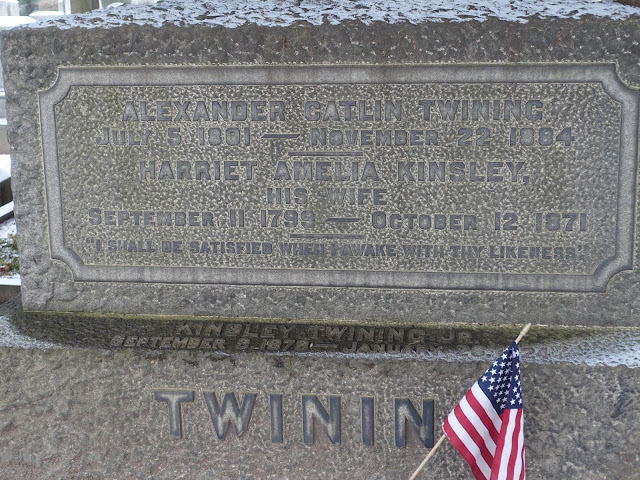But if, like me, you're trying to collect dead American entrepreneurs, you'll eventually need to bag the Big Kahuna. The original Steve Jobs. The Henry Ford-before-there-was-a-Henry Ford.
So, that's what I did. On my way home from a visit to Gettysburg I stopped at the Grove Street Cemetery, in the shadow of Yale's impressive Sterling Law Building. That's where I found Eli Whitney. (My first post on this early entrepreneur and his incredible, final invention is here.)
Whitney is the Father of Interchangeable Parts--maybe. He's the patron saint of the American System of Manufactures--perhaps. He's the inventor of the cotton gin--quite probably. And in the 20th century, Whitney became a major bone of contention among technology historians--for sure. At his death, however, there was no confusion. The prestigious Niles Register termed his loss in 1825 a "public calamity."
So, on a snowy March morning in 2016, we finally met.

At the other end of the Grove Street Cemetery from Whitney and Morse lies an entrepreneur whose name has become a modern brand.

It was Charles Goodyear who accidentally discovered and then patented vulcanized rubber--a patent, like Whitney's patent on the cotton gin, that turned out to be more heartache than it was worth. (Whitney eventually prevailed in court; Goodyear did not.) Goodyear died in 1860 but it wasn't until 1898 that the Goodyear Tire and Rubber Company was founded, preserving his fame.
And, as you can see, Goodyear was in the fourth class (1976) inducted into the National Inventors Hall of Fame with some other pretty good company.
 |
| The 1973, 74, 75 and 76 inductees into the National Inventors Hall of Fame. Those in yellow received special IEEE recognition. |
Colonel David Humphreys was an officer under Washington in the Revolution and became Ambassador to Spain. His entrepreneurial claim to fame--introducing a classic Schumperterian combination to the market--was to import the first Merino sheep to America.
Benjamin Silliman was a professor, abolitionist, teacher to Samuel Morse, and founder of the American Journal of Science.
He also happened to be the first person in America to distill petroleum. Unfortunately, that was in 1854, predating the automobile by a half century.
James Brewster, seventh generation from Elder Brewster of the Mayflower, was a carriage maker and involved in the early New Haven to Hartford railroad, becoming its president.
Eli Whitney Blake was the nephew of Eli Whitney and helped his famous uncle organize a gun factory at Whitneyville, just a few miles from the cemetery. After his uncle's death, Blake invented and patented a series of locks and latches, running a specialty hardware business. However, his real claim to fame was the Blake Stone Breaker, a machine that helped with the macadamizing of streets.
Noah Webster, called the Father of American Scholarship and Education, created the "Blue-Backed Speller" to teach American children how to read. It went on to sell 100 million copies. In 1806, Webster produced his first dictionary. That sold pretty well, too.
And I'll close our entrepreneurial walk through the Grove Street Cemetery with what is, I'm pretty sure, the prototype for LinkedIn.
This is the first resume I have ever seen carved in stone. It clearly takes to heart the advice, "try to keep it to one page."
A few closing shots of this beautiful and historic cemetery:
I'm ordering a couple of these bad boys for my grave site. Or bad girls? maybe.




























